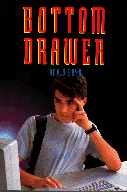


|
Bottom Drawer.
David Boyd.
Grades 9 and up / Ages 14 and up. *** /4
|

Bottom Drawer, a novel by David Boyd, is an ambitious and fairly successful teen problem novel. The teen in question, Mac Kuper, or "MacKid" as he calls himself on the Internet, must grapple with the memory of his father's suicide ten years earlier, and with a difficult relationship with his step-father, Malcolm. Then his life is further complicated by a close friendship which demands his decency and bravery. Tested by this experience, Mac feels that he has failed and betrayed his friend and himself.
The novel is prefaced by an impressionistic description of the
suicide of Mac's father, or more properly, the immediate effects of this
act on Mac. But the story proper begins with Mac's own suicide attempt ten
years later. The rest of the novel proceeds to describe the causes of his
attempt and the slow process of regaining peace of mind.
The novel is written in a number of different styles. Straight
narrative is used sparingly. Instead, the author elects to tell much of
the story through newspaper clippings, faxed memos, interview
transcriptions, and internet chat room printouts. I found these techniques
both engaging in their variety and effective in recreating the individual
voices of the speakers. The novel is also widely allusive, gaining
particular effect from references to The Catcher in the Rye and the
paintings of Alex Colville. These aspects of the novel will appeal to a
literate teen reader.
The main character is drawn with insight and sensitivity. Here,
Mac is tormented by the taunts of a neighbourhood bully shortly after his
father's death:
Mac sat down and brushed away the hot tears. If his daddy was here, he'd get Chase Robertson and bash his bike into smithereens, and he'd punch Chase's mom right on her big fat freckled nose! Chase was a liar, liar, liar!Mac sniffed and rubbed again where the collar had chafed his neck.
For the life of him, he didn't have a clue what a sue-side was.
However, the supporting characters, particularly the parents, aren't
allowed to expand much beyond stereotypes. These predictable characters
are one flaw in the novel. Another difficulty, one that afflicts many
problem novels, lies in the plot. Events move from the all-too-likely to
the all-too-unlikely swiftly, and as the plot heats up, the story slows
down. Even the author seems to feel this; he supplies a surprisingly brisk
denouement, as if the problems he has created for Mac are too big, or too
improbable to bear a more considered solution.
Nonetheless, this aggressive plotting may well appeal to those
readers who are not intrigued by the shifting voices and subtle insights
offered earlier in the novel. Although the book cannot sustain the light
touch or depth of feeling evident in the opening sections, it has a number
of qualities that make it an enjoyable read.
Recommended
Esmé Keith is an English teacher at a Winnipeg high school.

To comment on this title or this review, send mail to cm@umanitoba.ca.
Copyright © 1996 the Manitoba Library Association. Reproduction for personal use is permitted only if this copyright notice is maintained. Any other reproduction is prohibited without permission.
Published by
The Manitoba Library Association
ISSN 1201-9364
AUTHORS |
TITLES |
MEDIA REVIEWS |
BOOKSHELF
BACK ISSUES |
SEARCH |
HOME